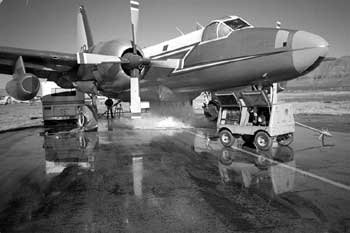 Privacy
| Legal Privacy
| Legal |
Table of Contents Back | Next | Cover Page |
Technology & Development Center |
How to Conduct Static Tests of Aerial Retardant Delivery Systems
Since the 1950s, the U.S. Department of Agriculture (USDA) Forest Service has performed numerous drop tests to quantify the ground pattern deposition of aerial retardant delivery systems. During drop tests, aircraft drop retardant onto a grid of cups. The amount of retardant in each cup is measured to determine the amount of retardant reaching the ground at particular points (the ground pattern of deposition).
For a history of drop testing, refer to Drop Testing Airtankers: A Discussion of the Cup-and-Grid Method (0057–2868–MTDC, /t-d/pubs/htmlpubs/htm00572868/, Username: t-d, Password: t-d). During the course of these tests, scientists developed a relationship between drop configuration factors and deposition characteristics. The drop configuration factors include drop height, drop speed, ambient wind, temperature, humidity, retardant rheological properties, and flow history (flow rate). Of these factors, variation in flow rate produces the most variation in deposition characteristics.
In the early 1980s, a procedure known as static testing (Blakely, George, and Johnson: Static Testing to Evaluate Airtanker Delivery Performance, Gen. Tech. Rep. INT–78, February 1982) was developed to measure airtanker flow rate data that could be applied to ground pattern prediction models. The procedure is called static testing because it is performed with the aircraft on the ground rather than in flight (figure 1).

Figure 1—A static test of the Neptune P2V. An auxiliary power
unit can
supply power, eliminating the need to run the plane's
engines during the
test.
The tank can be mounted in the aircraft or on a test stand that allows the tank to be operated as if it was installed in the aircraft. In either case, the drop controller that electronically controls the flow rate and power to the system must be identical to that used during normal operation. The Forest Service performs static tests to gather information about system performance that can be applied to field use. Several Forest Service Technology and Development Program employees perform static tests.
Any owner, designer, or operator of a tank and gating system may request a static test to gather information about the system. If the operator intends to bid for a Government Exclusive Use contract, the Interagency Airtanker Board (IAB) must first approve the system. In the early 1980s, the IAB established airtanker performance criteria. The IAB has made several revisions since then. For a copy of the current criteria, send an e-mail message to: glovellette@fs.fed.us. Section 1 of the criteria lists the steps that operators must complete to attain IAB approval. One step is to complete a static test or drop test to evaluate system performance. The IAB determines which test is required on a case-by-case basis.
Usually, a static test will suffice if a similar system has been drop tested. The operator must make the initial contact with the IAB and complete the approval steps that lead to the static test. Then, the operator can contact the test team to begin preparations for the static test. The test team works as an advisor to the IAB and performs static tests at the board's request. The test team makes recommendations to the IAB based on the results of static tests.
An operator may request a static test for reasons other than IAB approval. For example, systems that carry less than 800 gallons or those used outside the United States do not need to be approved by the IAB. Operators may wish to document that a system meets IAB criteria to make their products more marketable. If the test team is notified by the operator, the team will determine whether the operator needs to contact the IAB before proceeding further.
Once a static test is complete, the test team will send the results to the operator and to the IAB. If the operator is seeking IAB approval, and the test is successful, the test team also will include a letter recommending approval to the IAB. This does not mean the system is approved. Final approval is made only by the IAB through a formal letter of approval. Systems tested outside the IAB approval process may require additional testing if the operator seeks approval later.
Forest Service policy requires the operator to pay all costs associated with the test through a collection agreement. The costs include wages, travel, and per diem for the test team. The collection agreement includes an estimate of the cost of performing the test and outlines the responsibilities of the USDA Forest Service and of the operator. Payment must be received before testing begins.
To start preparing for a test, the team needs a general description of the tank including tank drawings (preferably in electronic form). Knowing the type, design, and size of the tank will help the team identify the test goals and discuss them with the operator.